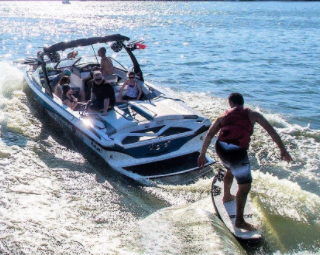New peer-reviewed paper analyzes wakesurfing shore impact

The Journal of Water Resource and Protection, a monthly journal featuring state-of-the-art research works, recently published a new paper titled, Numerical Study of the Impact of Wake Surfing on Inland Bodies of Water. Renowned researcher and computational fluid dynamic engineer in the marine space, Endicott (Cotty) M. Fay, is among the paper’s lead researchers.
The paper quantifies the impact related to turbidity and erosion with the use of computational fluid dynamics (CFD) of boat wakes in shallow water and the build-up of wind driven waves. In its findings, the paper details that when wake surfing at least 200 feet from shore and in water that has a depth of at least 10 feet, the environmental impact is minimal.
The paper also concludes:
- Boat wakes dissipate quickly and have little impact on shorelines compared to wind driven waves.
- Multiple simulations show great loss of wave energy at various distances from shorelines. In each case, a boat operating at 200 feet from shore and in water depths greater than 10 feet are optimal for shoreline and environmental health.
- The amount of sediment caused by shoreline erosion from boat traffic or wind driven waves is insignificant compared to the amount of sediment that flows in naturally through a lake’s watershed.
- Boat wakes can increase oxygenation, which is beneficial for aquatic species.
“This peer-reviewed study confirms that shorelines are minimally impacted when wake surfing at a distance of 200 feet from shore, in waters of 10 feet of depth or greater,” said Cotty Fay, lead research engineer. “While waves from wake surfing at a distance of 200 feet from shorelines may still wash up on shore, our analysis concludes these waves will not be carrying enough force to degrade shorelines, especially when compared to wind driven waves. Additionally, wake surfing in water at a depth of at least 10 feet protects the water bottom, seagrasses, and aquatic life.”
“The recreational boating industry has long focused its efforts on proactive education for consumers and boat operators that maintain the health of our waterways, protect our ecosystems, and ensure the safety of everyone on the water,” said David Dickerson, vice president of state government relations at the National Marine Manufacturers Association (NMMA). “This latest research from renowned researcher Cotty Fay stresses the importance of wake surfers maintaining a 200 foot setback from shorelines and docks, while operating in water of at least 10 feet of depth.”
The research used advanced simulations to analyze possible shoreline erosion and turbidity that wake surfing causes on waters’ bottom and shoreline impacts. The energy, type and direction of a boat’s wake are described quantitatively in tables, which may be used for predicting wind driven waves over varying fetches, depth and wind speeds is provided.
The study can be accessed online here.




